|
02-25-04 Composite or masonite board sealed on top with cement adhesive/bonder. Metal lath attached with gorilla glue, adhesive bonder in #60 sand lime mortar, alum in mortar. Alum, casein limewater in medium. top coat #16 sand, 1:1 with lime and alum. First a coat of Green Earth with a medium of lime water and casein on a mortar with casein in it. (Later I would learn not to use casein or adhesive bonder in the mortar.) 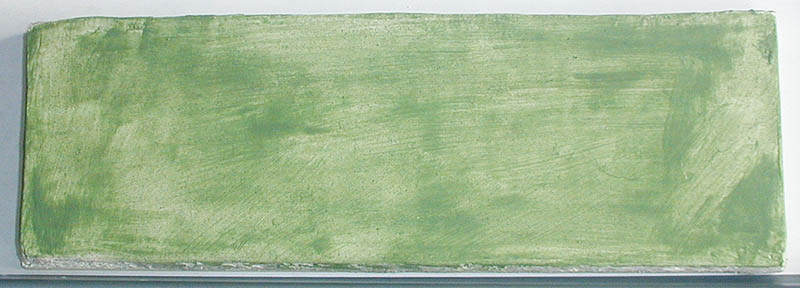 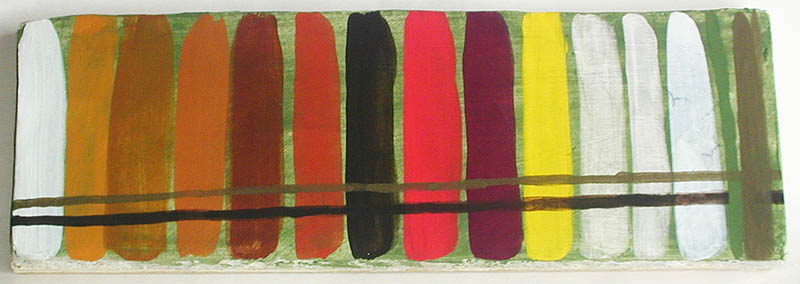 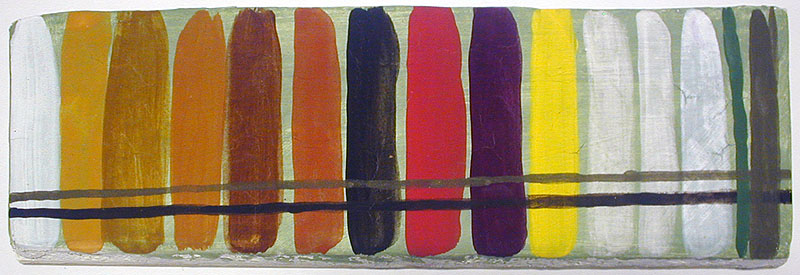 1. Titanium White 2. Yellow Ocher 3. Raw Sienna 4. Italian Warm Ocher 5. Burnt Sienna 6. Ercolano Red, Hurculaium Red 7. Burnt Umber 8. Cadmium Red 9. Quinacridone Magenta 10. Cadmium Yellow 11. Lime Pigment 12. Lime Pigment, Lime white pigment goes on very translucent and not at all smoothly. It quickly becomes more opaque. 13. Zinc White, applies at about the same translucentcie as the lime white pigment lightens to while wet. 14. Chromium Green Oxide 15. Verdaccio First stripe, Vardaccio Second stripe, Burnt Umber 02-26-04 1/4 inch hard pressed masonite board sealed on top with cement adhesive/bonder, Metal lath attached with gorilla glue, one tack every 2-3 inches. Adhesive bonder in #60 sand lime base mortar. Top coat 1:1 lime and #16 sand only, no adhesive/bonder or alum, this is a very dry mix. I forgot to wet the support and only gave it one coat of binder, it might crack because of this oversight. I used lime water only in the pigments. 10:00 First thin coat of Green Earth, wait until the shine is gone, second coat and wait. I'm using a lot of pigment and it is very translucent. The longer you wait between coats the less pick up. 11:00 Start adding test colors. The smoothest stroke is made with the brush barely touching the surface in short strokes, so the mortar pulls the pigment from the brush, which it does. The short strokes gives the pigment time to work with gravity and fill the tip again. 12:45, Finished painting test colors, still absorbing well. I didn't photograph it until 6 hours later :(. Color changes have already happened. It just doesn't seem like zinc white has any power. Lime pigment is warm, titanium white is cool and WYSIWYG. 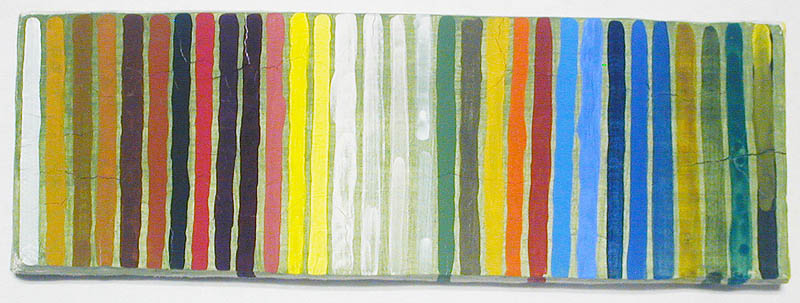 Day 7, very little color change, these pigment are great in lime. 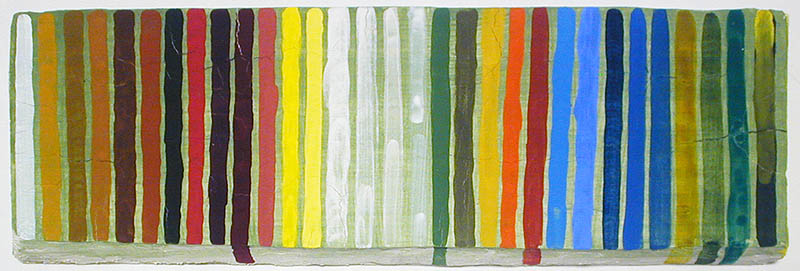 1. Titanium White 2. Yellow Ocher 3. Raw Sienna 4. Italian Warm Ocher 5. Burnt Sienna 6. Ercolano Red, Hurculaium Red 7. Burnt Umber 8. Cadmium Red 9. Quinacridone Magenta 10. Alizarin Crimson 11. Genuine Vermilion is very dense and opaque. 12. Cadmium Yellow 13. Naples Yellow 14. Lime Milk 15. Lime Milk plus Zinc White, applied easier then lime milk alone, looked the same while applying. 16. Neutral Lime Pigment, went on the most transparently and quickly whitened brighter than lime milk or lime milk and zinc white, but not as bright as titanium white. (This must have driven the old masters crazy.) 17. Zinc White, applies at about the same translucency as the lime white pigment but is a much cooler color. 18. Chromium Green Oxide 19. Verdaccio 20. Light Gold Ocher 21. Cadmium Orange 22. Cerulean Blue 23. Cobalt blue light 24. Thalo Blue 25. Blue and Cobalt Blue Light 26. Blue and Cerulean Blue 27. Yellow 28 Yellow and Thalo Blue 29. Viridian Extra 30. Vineblack and Cadmium Yellow
Test colors over Titanium White, Green Earth, Vermilion Genuine, Green Earth, Cadmium Red, and Burnt Sienna. I put glue on a base that was cracked and glue in the intonaco. intonaco = 1 small sand and .5 small crushed limestone, 1.5 lime = 1:1
The support was finished at 2:05 with a fairly dry dry mortar. It started cracking in 15 minutes. Maybe I applied it too dryly.
12:25 limewater medium only.. start adding base pigments.. titanium white covered quickly, vermilion genuine absorbed quickly, green earth is very transparent and soaks in slowly, wait, add another layer, wait, add another and another, cadmium red, burnt sienna is translucent and it takes a lot of pigment to become opaque, it soaks in quickly.
3:45 add first overlay colors, Horizontal, Light Gold Ocher, Yellow Ocher, Raw Ocher, Italian Warm Ocher, Burnt Sienna, Burnt Umber, Titanium White. I can't be sure yet but I think titanium white wasn't pulling right. 4:10 stop.
5:05 add second overlaid colors, Vertical, Light Gold Ocher, Yellow Ocher, Raw Ocher, Italian Warm Ocher, Burnt Sienna, Burnt Umber, Titanium White. 5:25 stop.
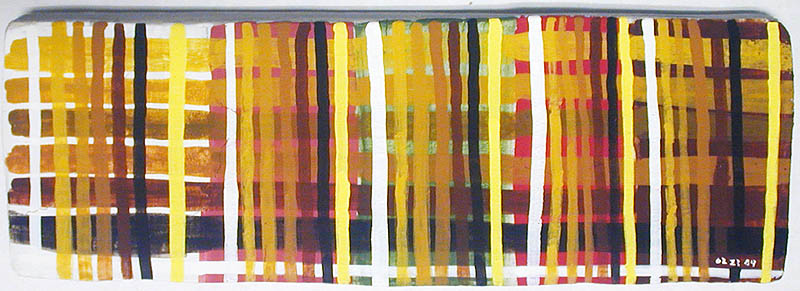
Here are the second day results. Woa..
Day 3 showed no difference in colors. 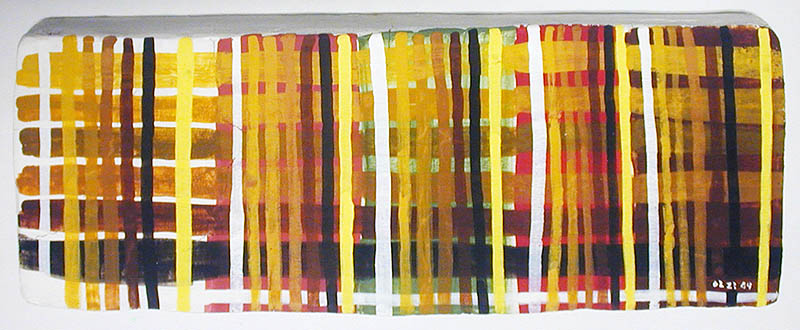 12:45 Start and finish a Small Lilly fresco, same mortar a little wetter and it is not cracking.. yet. Finished Small Lilly 3:45, background is Italian White Earth, lilly is Quinacridone Magenta and Titanium White with some Thalo Red. The mortar started cracking even with the glue in it and the mortar is still soft enough to finger dent.. the glue did not effect the pull. My painting technique is finish every small area compleatly, for the lilly it was one petal at a time. Checking It on the second day shows it made it fine, all the colors were locked up. All painted with only lime water, no wash tints, only opaque tints made with titanium white so I could see the final color as I was painting it. By the way, Titanium white has to be washed out of the brush with soap and water just like all the modern colors. Here is day right after it was painted and day three. The cracks are bigger.. That's because I didn't scrub off the carbonate before adding the intonaco. Or.. maybe the glue I added to the mortar was a bad idea. 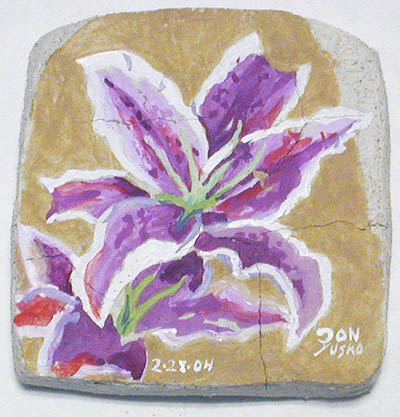 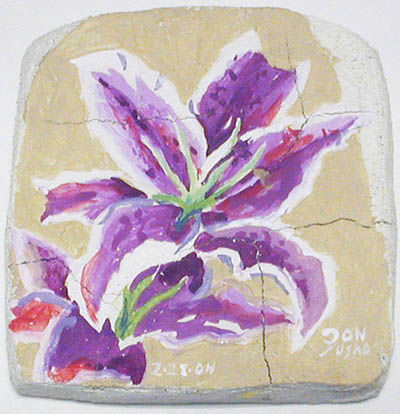 |